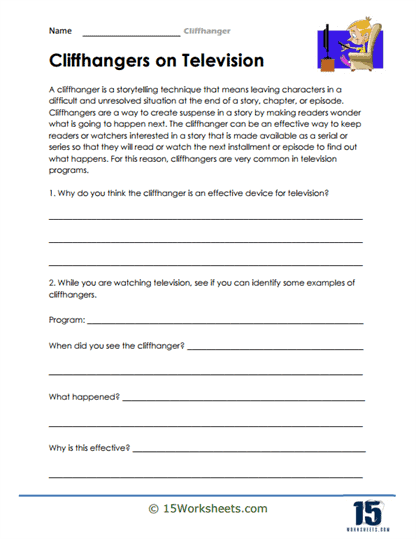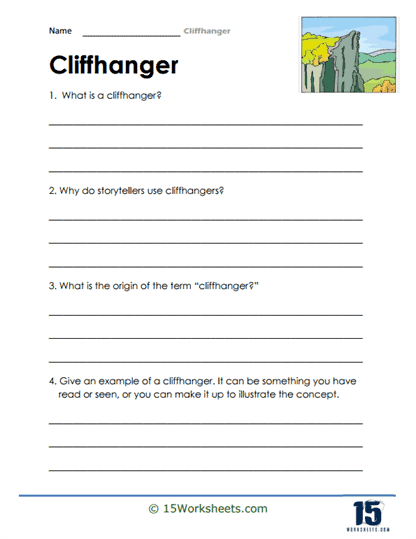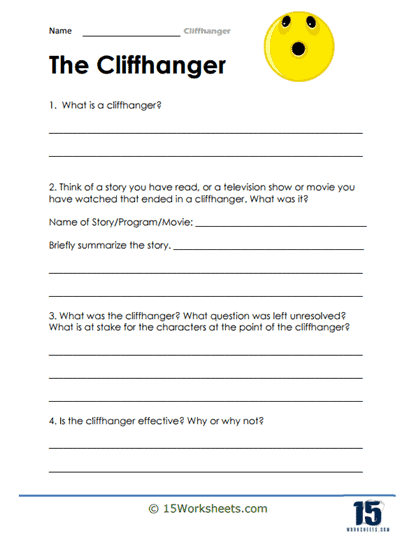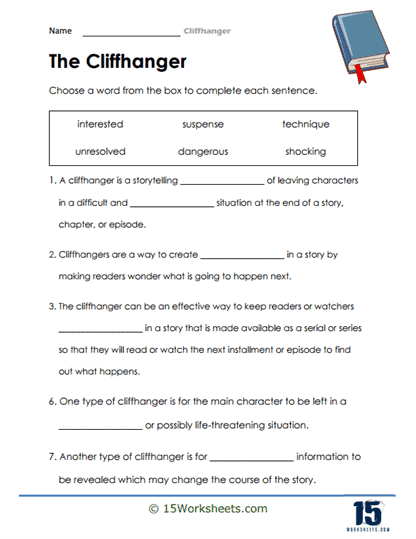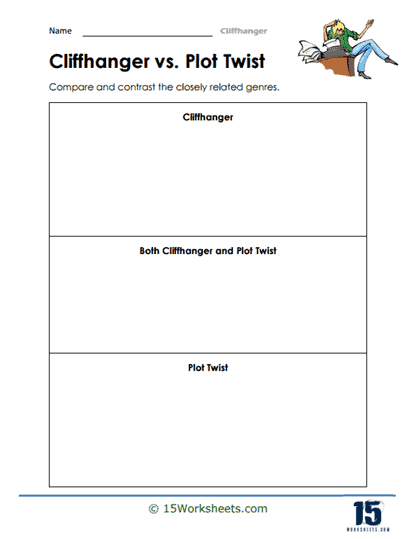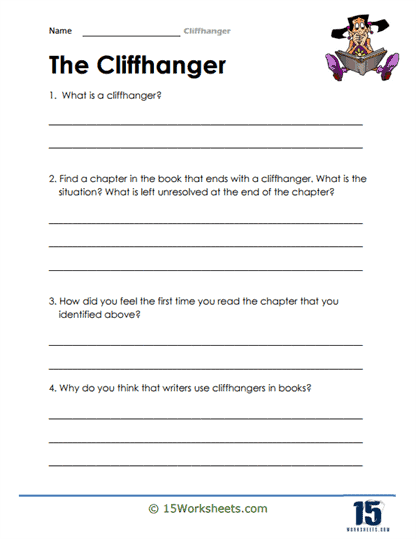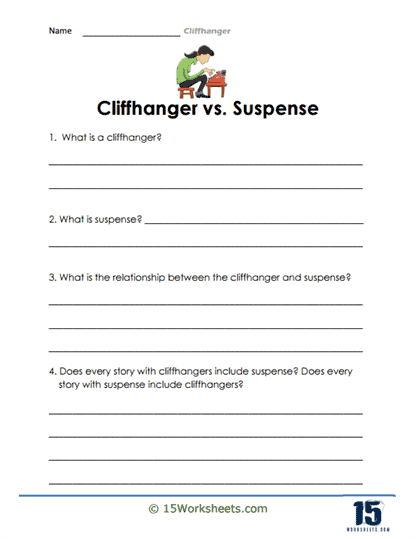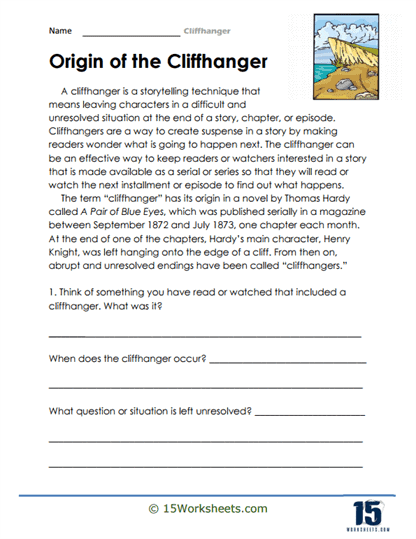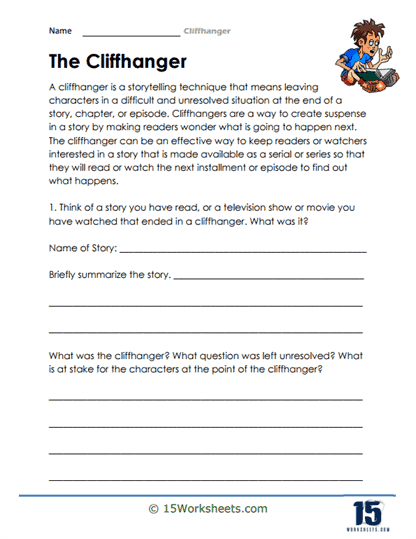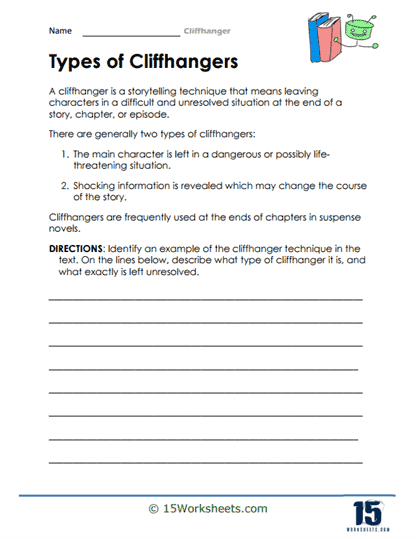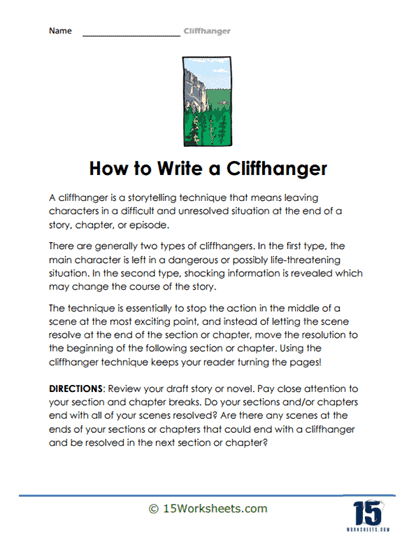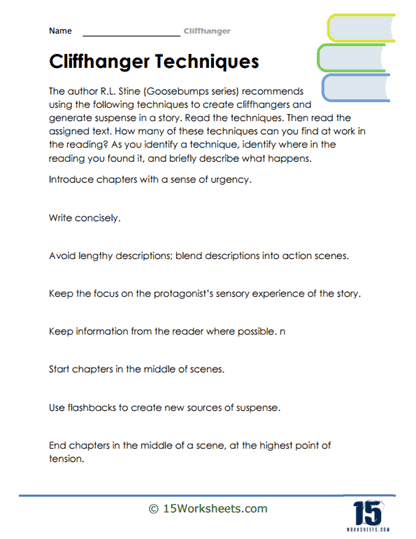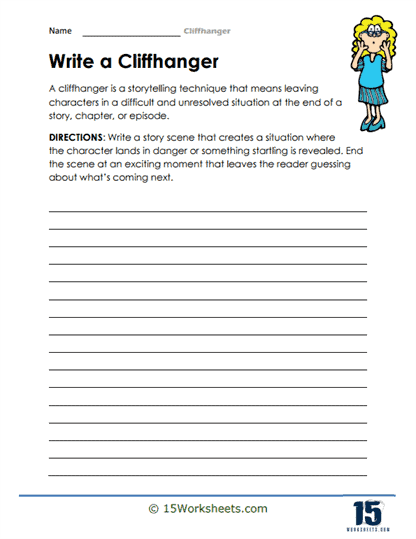Cliffhanger Worksheets
All About These 15 Worksheets
Cliffhangers, those tantalizing narrative devices that leave audiences hanging on the edge of their seats, are a thrilling and essential element of storytelling. Understanding and effectively employing cliffhangers not only deepens a student’s appreciation for the art of suspense but also enhances their reading comprehension, critical thinking, and storytelling skills.
In a world where captivating narratives, engaging communication, and impactful writing are highly prized, students must develop the ability to recognize, analyze, and employ cliffhangers to keep readers or viewers hooked.
To empower students with the knowledge of cliffhangers and their storytelling techniques, we proudly present a collection of 15 worksheets. These worksheets are meticulously designed to provide students with structured and engaging opportunities to explore, practice, and master the art of crafting and analyzing cliffhangers.
What Are Cliffhanger Worksheets?
Cliffhanger worksheets are used to help students understand and practice the concept of this literary device in literature. Cliffhangers are suspenseful situations at the end of a chapter, scene, or episode that leave the audience eager to know what happens next. They are used by writers to keep readers or viewers engaged and looking forward to the next part of the story.
These worksheets include activities and exercises designed to help students identify, analyze, and create their own cliffhangers. These worksheets are a fun and engaging way to teach students about narrative structures and techniques. They can be used with various age groups and reading levels, depending on the complexity of the exercises. Here are the types of exercises that you can expect on these worksheets:
Identification – These exercises might include a series of passages from books, short stories, or scripts. Students are asked to identify which passages end with a cliffhanger. This helps students understand what a cliffhanger is and how it works to build suspense and encourage continued engagement with a story.
Analyzing – In these exercises, students are given specific examples of cliffhangers and asked to analyze how they create suspense. Students might discuss the emotions the cliffhanger evokes, the questions it raises, and how it affects their desire to continue reading or watching. This helps students delve deeper into the narrative techniques used to create cliffhangers and the effects they have on the audience.
Creating Your Own – These exercises might involve creative writing prompts where students are asked to write their own cliffhangers. For example, they might be given the beginning of a story and asked to write a cliffhanger ending for it. Alternatively, they might be asked to rewrite the ending of a story to turn it into a cliffhanger. This not only stimulates creativity but also allows students to apply their understanding of the concept in practice.
Comparing and Contrasting – These activities might involve comparing cliffhangers from different stories or authors to analyze the different techniques used. Students might be asked to discuss how the cliffhangers affect their response to the story and their eagerness to continue reading.
Cliffhanger worksheets are an effective way to teach students about this critical narrative technique. By identifying, analyzing, and creating their own cliffhangers, students can gain a deeper understanding of how suspense is built in storytelling and how it serves to engage the reader’s attention. They also provide an opportunity for creative expression and critical thinking, making them an excellent tool for developing both literary and writing skills.
What is the Literary Device of Cliffhanger?
A cliffhanger is a narrative technique where a story or a section of a story ends abruptly at a suspenseful or dramatic moment, leaving the readers in a state of uncertainty about what will happen next. It has been an integral part of storytelling for centuries, employed by authors to create suspense, build anticipation, and ensure their audience’s return for more.
The term cliffhanger originated from the serialized Victorian novels where characters were often left in perilous situations, including literally hanging off cliffs. Since then, the technique has been adapted widely across various forms of media, including literature, film, television, and even video games.
The cliffhanger is a powerful literary device due to its capacity to evoke strong emotional responses from the audience. By leaving characters in the midst of a crisis or an unresolved situation, the readers are compelled to imagine various outcomes and are enticed to continue reading to alleviate their suspense.
The main defining feature of a cliffhanger is the intentional withholding of narrative resolution. This can take on many forms – a character’s fate may hang in the balance, a significant plot twist may be revealed without its implications being explored, or a critical question may be raised without being immediately answered. No matter the specifics, a cliffhanger always leaves the audience on the edge of their seat, yearning to find out what happens next.
Examples in Popular Literature
1. “A Game of Thrones” by George R. R. Martin
One of the most memorable cliffhangers in contemporary literature is at the end of “A Game of Thrones”, the first novel in the “A Song of Ice and Fire” series. The novel ends with Daenerys Targaryen stepping into her husband’s funeral pyre with three fossilized dragon eggs. The chapter ends there, leaving readers in suspense about her fate. When the narrative resumes in the next book, Daenerys emerges unharmed with three newly hatched dragons. This cliffhanger is particularly effective because it leverages the fantastical elements of the series, and it raises the stakes for the upcoming narrative by introducing the return of dragons into a politically complex world.
2. “The Silence of the Lambs” by Thomas Harris
This psychological horror novel contains a gripping cliffhanger that serves as a pivotal moment in the series. Near the end of the book, the sociopathic antagonist, Dr. Hannibal Lecter, escapes from prison. The narrative then ends, leaving readers wondering what will become of this dangerous character. In the subsequent novel, “Hannibal”, we find Lecter living under a new identity in Italy, setting the stage for another thrilling cat-and-mouse chase. This cliffhanger is highly effective in that it allows the menace of the antagonist to linger well beyond the pages of the book, creating anticipation and suspense for the following novel.
3. “Harry Potter and the Goblet of Fire” by J.K. Rowling
The fourth book in the “Harry Potter” series ends with a major cliffhanger that signals a darker turn for the remaining novels. Harry is transported to a graveyard where the antagonist, Lord Voldemort, is resurrected. Although Harry manages to escape and return to Hogwarts, the novel ends with his report of Voldemort’s return being met with disbelief by the wizarding authorities. The implications of this cliffhanger, such as the threat of Voldemort and the institutional denial, create a sense of looming danger for Harry and his friends, leaving readers eager to delve into the next book.
In conclusion, the cliffhanger is a versatile and powerful literary device that authors use to create suspense and ensure their readers’ continued engagement with the narrative. By leaving critical plot points unresolved, they encourage the reader to speculate about possible outcomes and remain emotionally invested in the characters and their fates. These narrative gaps also stimulate curiosity and anticipation, thus enhancing the reader’s overall immersion and enjoyment of the story. The technique of the cliffhanger demonstrates the profound impact that narrative structure can have on the reader’s experience, making it a vital tool in the author’s storytelling arsenal.
The Importance of Understanding Cliffhangers For Students
Understanding cliffhangers and their various forms is of great importance for several reasons:
- Literary Appreciation: Cliffhangers are a fundamental element of literature, adding excitement and intrigue to stories. Recognizing cliffhangers enhances students’ appreciation of narrative structure and suspense.
- Critical Thinking: Identifying and analyzing cliffhangers challenges students to think critically about plot development, character motivation, and the art of storytelling.
- Engaging Communication: Proficiency in understanding and employing cliffhangers sharpens students’ communication skills, enabling them to captivate their audience and keep their attention.
- Creative Writing: Learning the techniques of crafting cliffhangers empowers students to create compelling narratives that leave their readers eager for more.
This collection of Cliffhanger worksheets is a valuable resource for educators and parents committed to nurturing literary appreciation, critical thinking, and storytelling skills in students. Proficiency in recognizing, analyzing, and crafting cliffhangers equips individuals with the tools to engage with narratives on a deeper level, keep audiences enthralled, and create stories that leave a lasting impact.
This collection is an investment in their future success as storytellers and critical thinkers, ensuring they have the skills to captivate, engage, and entertain in a world where the art of suspenseful storytelling continues to hold a special place in the hearts of audiences everywhere. Explore these Cliffhanger worksheets today, and watch your students become skilled storytellers who know how to keep their audience eagerly anticipating the next thrilling chapter.

